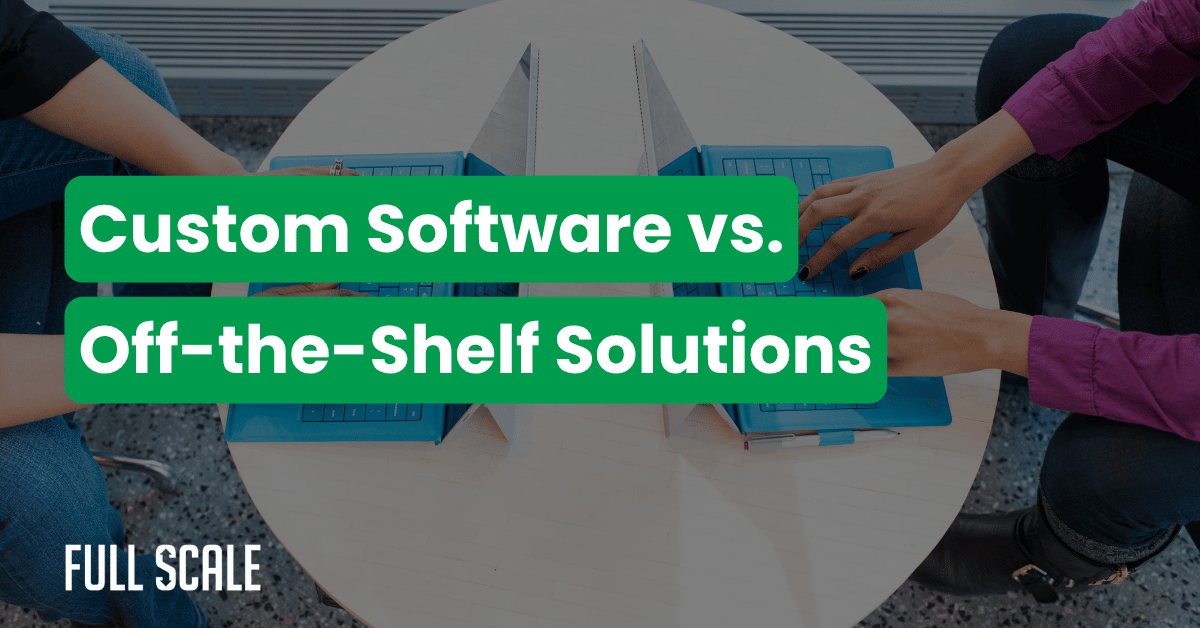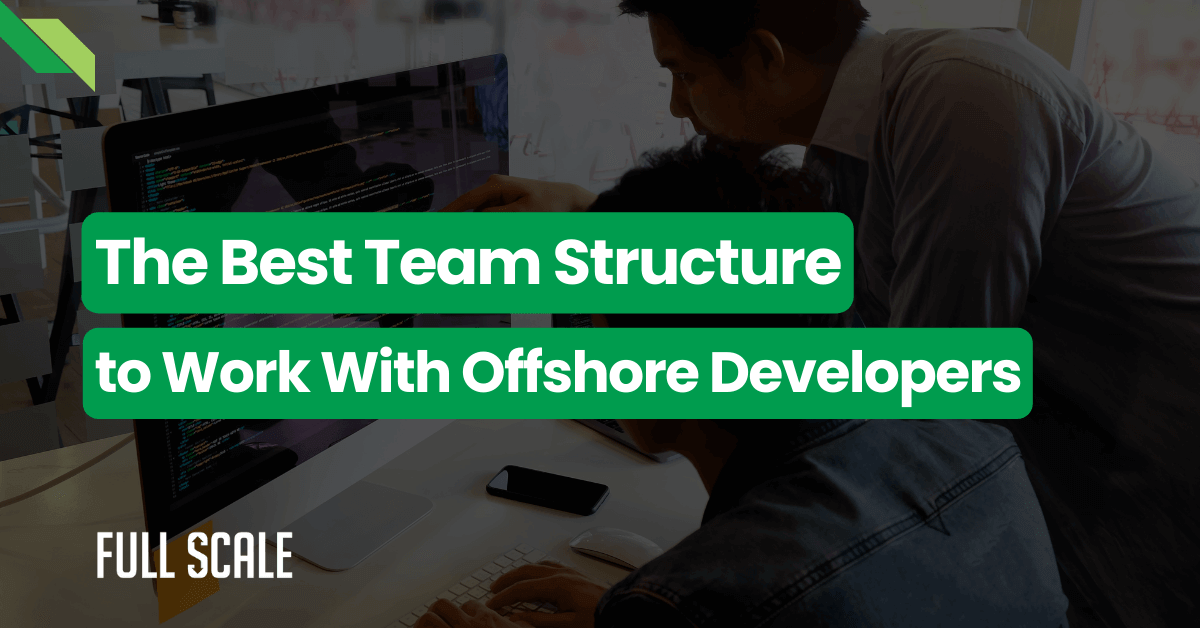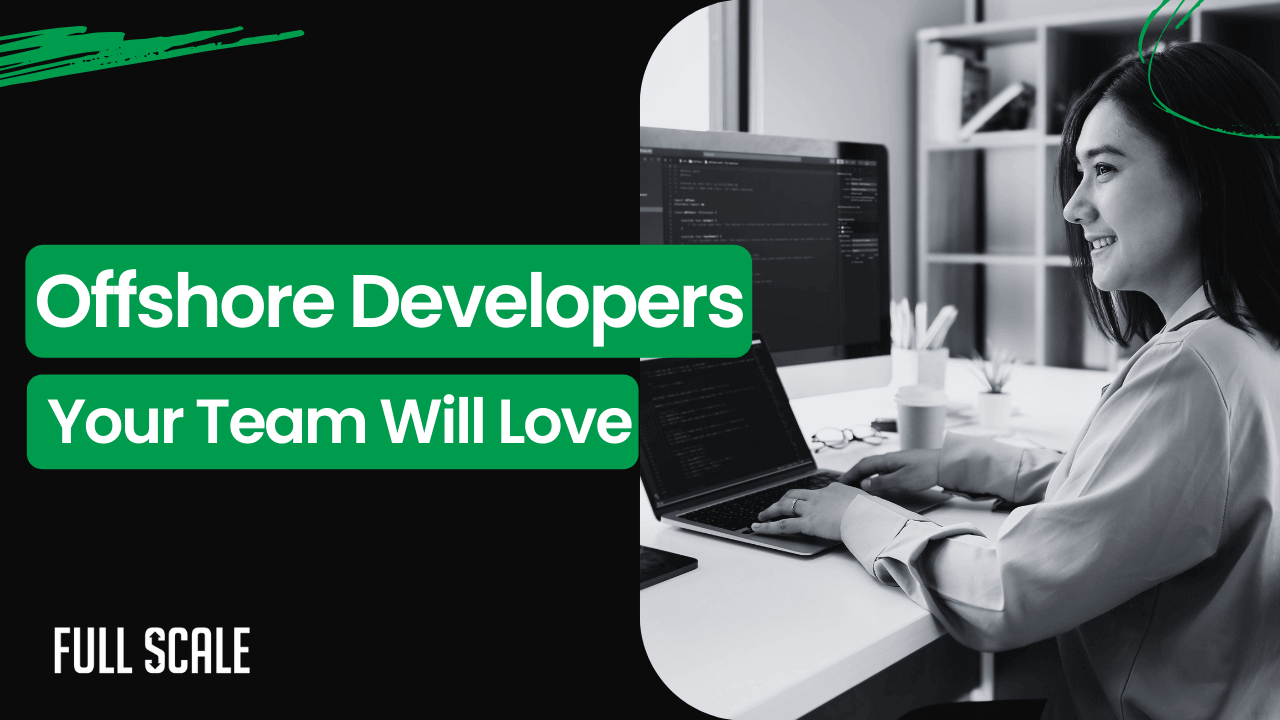Choosing between custom software vs. off-the-shelf solutions represents critical technology decisions facing growing businesses.
This comprehensive analysis examines the custom software vs. off-the-shelf debate with data-driven insights. The custom software vs. off-the-shelf comparison requires evaluation of costs, timelines, and business impact.
Choosing between Custom Software vs. Off-the-Shelf Solutions
Software decisions impact business growth for decades. Custom software offers a 300% higher ROI for companies exceeding 500 users.
Off-the-shelf solutions provide 60% faster deployment for standard business processes.
Choose custom software when:
- A unique competitive advantage is required
- Scalability demands exceed vendor limitations
- Long-term ROI justifies the initial investment
Choose off-the-shelf software when:
- Standard business processes suffice
- Budget constraints limit custom development
- Time-to-market is critical
Growing businesses save $2.4 million annually through strategic software choices. This analysis provides frameworks for CTOs, Product Directors, CFOs, and HR leaders.
The $1.3 Trillion Software Decision
Companies spend $1.3 trillion annually on software solutions globally. Recent McKinsey research indicates 73% of businesses regret their software choice within two years.
Gartner’s 2024 IT spending forecast shows that poor software decisions cost businesses an average of $15 million.
This comprehensive guide addresses critical software procurement decisions across organizational roles.
The custom software vs. off-the-shelf analysis becomes increasingly complex as businesses scale. Decision-makers require data-driven frameworks supporting strategic technology investments.
Key insights this article provides:
- Comprehensive cost analysis frameworks for custom software vs. off-the-shelf evaluation
- Real-world case studies demonstrating successful implementation strategies
- ROI calculation models with break-even analysis timelines
- Decision frameworks tailored for different organizational roles and priorities
- Risk mitigation strategies for both custom software development and off-the-shelf implementation
CTOs need technical scalability frameworks addressing performance optimization requirements. Product Directors require delivery acceleration strategies balancing speed with competitive differentiation. CFOs demand ROI analysis quantifying the total cost of ownership across five-year projections.
HR Directors seek talent management integration solutions supporting distributed team collaboration. The analysis covers detailed cost breakdowns, implementation timelines, and strategic decision frameworks. Interactive calculators provide personalized cost projections, evaluating custom software vs. off-the-shelf alternatives.
Understanding Your Options: Definitions & Examples
The custom software vs. off-the-shelf decision requires clear understanding of available alternatives. Each approach offers distinct advantages depending on business requirements and technical constraints. Proper evaluation ensures optimal alignment between software capabilities and organizational needs.
What is Custom Software Development?
Custom software development creates tailored applications addressing specific business requirements. Organizations build proprietary solutions matching unique workflows and competitive advantages. Development teams design architecture, features, and integrations from ground up.
Industry Examples
- FinTech: Stripe developed custom payment processing systems, handling billions in transactions
- HealthTech: Epic created hospital management platforms that manage patient data across 250+ facilities
- E-commerce: Amazon built proprietary logistics software, optimizing delivery routes and inventory management
Custom software solutions allow businesses to control functionality and performance optimization. Businesses own intellectual property and can modify features without vendor restrictions. Depending on complexity, custom software development costs range from $100,000 to $5 million.
Custom software development becomes clearer when successful implementations are examined. Custom software enables the implementation of proprietary business logic and competitive differentiation strategies. Organizations choosing custom software development gain unlimited scalability potential and complete technical control.
What is Off-the-Shelf Software?
Off-the-shelf software provides pre-built solutions addressing common business needs across industries. Vendors develop standardized applications serving multiple use cases through established frameworks.
Implementation involves configuration rather than ground-up development processes.
Software Categories:
- COTS (Commercial Off-The-Shelf): Enterprise resource planning systems like SAP
- SaaS Solutions: Cloud-based applications like Salesforce CRM
- Open-Source Alternatives: Community-developed platforms like WordPress
Off-the-shelf software vs. custom-built comparison reveals faster deployment advantages. Vendors provide ongoing support, updates, and security patches through subscription models. Monthly subscription fees typically range from $10 to $300 per user.
Standard software solutions offer immediate functionality access without development timelines. The off-the-shelf software vs. custom-built decision favors pre-built solutions. Organizations benefit from vendor expertise and established best practices through implementations.
Hybrid Approach: Customized COTS
Customized COTS combines pre-built foundations with tailored modifications addressing unique requirements. Companies configure existing platforms while adding custom features through API integrations. This approach balances development speed with specific business process alignment.
Enterprise clients modify Salesforce with custom objects and workflows supporting unique sales processes. E-commerce businesses customize Shopify with proprietary checkout processes and inventory management. Healthcare organizations adapt existing EMR systems with specialized modules for regulatory compliance.
The build vs. buy software decision often results in hybrid implementations maximizing approaches. Custom software development companies frequently recommend hybrid solutions for complex enterprise requirements. This strategy reduces custom software development costs while maintaining competitive differentiation capabilities.
The True Cost Analysis: Breaking Down Every Dollar
Understanding true costs requires comprehensive analysis beyond initial investment projections. The custom software vs. off-the-shelf cost analysis reveals hidden expenses and implications. Strategic software development budget planning prevents costly surprises and ensures realistic expectations.
Custom Software Development Costs
Custom software development requires substantial upfront investment across multiple cost categories. Project complexity, team composition, and development timeline directly impact total expenses. Geographic location and the selection of a custom software development company significantly affect budget requirements.
Initial Development Investment
| Cost Component | Percentage | Cost Range |
| Development Team | 60-70% | $120,000-$350,000 |
| Project Management | 10-15% | $20,000-$75,000 |
| Quality Assurance | 15-20% | $30,000-$100,000 |
| Design & UX | 10-15% | $20,000-$75,000 |
How much does custom software development cost depends on regional rates and complexity. Custom software development services pricing varies significantly across global markets and expertise levels. Development timeline affects custom software development cost through resource allocation and management overhead.
Six-month projects average 20% lower costs than eighteen-month initiatives. Team size optimization reduces communication complexity and coordination expenses significantly. Why custom software development is important becomes evident when examining long-term benefits.
Custom solutions eliminate ongoing licensing fees and provide complete maintenance control. Organizations avoid vendor lock-in and associated price escalation risks through custom development. The custom software vs. off-the-shelf financial analysis supports strategic investment decisions.
Off-the-Shelf Software Costs
Off-the-shelf software costs extend far beyond the monthly subscription fees displayed in materials. Implementation, customization, and integration expenses accumulate rapidly throughout deployment phases. Hidden costs of off-the-shelf software often exceed initial budget projections significantly.
Visible Cost Components
| Cost Type | Annual Range | Notes |
| Software Licenses | $12,000-$360,000 | $10-300 per user monthly |
| Implementation Services | $25,000-$200,000 | Professional services required |
| Training Programs | $5,000-$50,000 | User adoption initiatives |
| Data Migration | $10,000-$150,000 | Legacy system integration |
Traditional cost estimates overlook critical ongoing expenses throughout software lifecycle management. Customization fees average $75,000 for enterprise implementations requiring workflow modifications. API integration custom vs. COTS software costs range from $15,000 to $100,000.
Ongoing support contracts add 20-25% annually to base licensing costs without guarantees. Vendor dependency creates long-term pricing risks beyond organizational control. License fee increases average 8-12% annually across major software providers, affecting predictability.
The custom software vs. off-the-shelf cost analysis reveals different expense patterns. Hidden costs of off-the-shelf software include data export fees and limitations. A software development cost comparison shows custom solutions achieving cost parity within months.
Total Cost of Ownership (TCO) Comparison
Five-year total cost of ownership custom vs. off-the-shelf software analysis reveals investment impact. Custom software shows higher initial costs but dramatically lower ongoing expenses. Off-the-shelf solutions demonstrate predictable initial costs with escalating vendor fees creating uncertainty.
5-Year TCO Breakdown
| Software Type | Year 1 | Year 2 | Year 3 | Year 4 | Year 5 | Total |
| Custom Software | $400K | $80K | $85K | $90K | $95K | $750K |
| Off-the-Shelf | $150K | $180K | $210K | $240K | $275K | $1.055M |
Custom software achieves cost parity by year three in typical enterprise deployments. Organizations save 30-40% over five years through strategic custom development investments. Break-even analysis shows 18-24-month payback periods for properly scoped projects.
The custom software vs. off-the-shelf comparison demonstrates clear financial advantages for implementations. Total cost of ownership analysis supports custom development for mission-critical applications. Software development cost comparison favors custom solutions beyond 36-month deployment timelines.
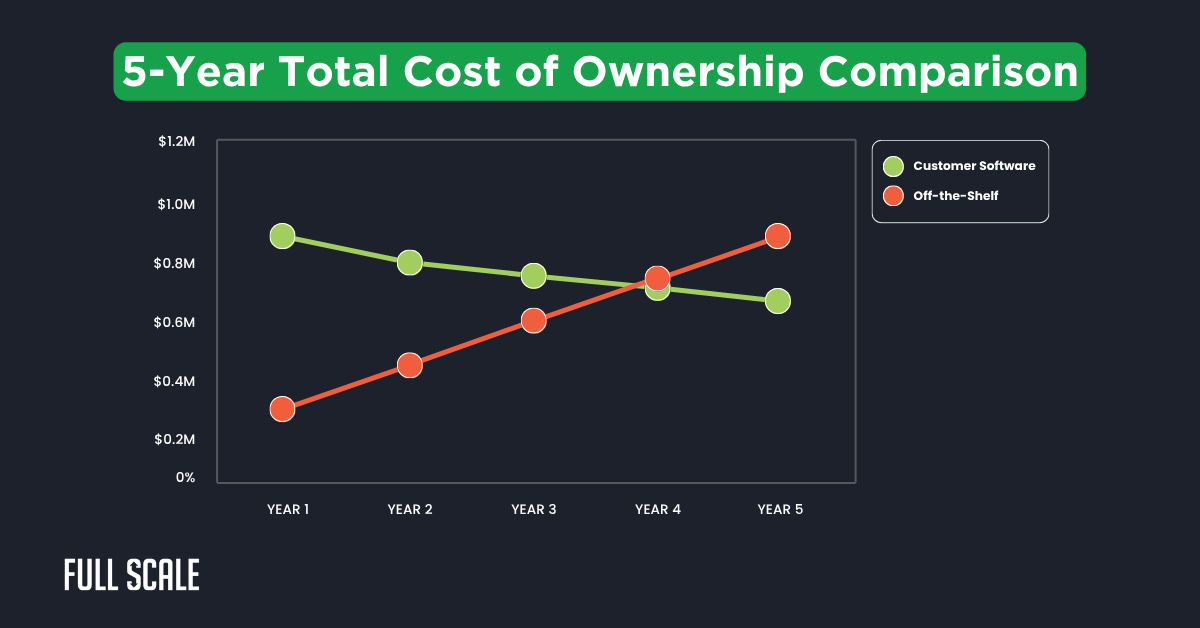
The Strategic Impact Analysis
Strategic software decisions extend beyond immediate cost considerations to long-term competitive positioning. The custom software vs. off-the-shelf evaluation requires analysis of market differentiation and scalability. Technical debt off the shelf vs. custom accumulation significantly impacts development capabilities.
Time to Market: Custom vs. Off-the-Shelf Software
Time to market custom vs. off-the-shelf software requirements heavily influence strategic decisions. Off-the-shelf solutions provide immediate deployment advantages for standardized business processes. Custom software requires longer development cycles but delivers precise requirement alignment.
Product development software decisions balance speed requirements with long-term strategic positioning. Standard implementations deploy within 1-6 months, depending on complexity and customization needs. Custom development spans 6-18 months, depending on feature complexity and team size.
Airbnb’s founders initially considered existing booking platforms for rapid market entry. Custom development required 12 months but enabled unique host-guest interaction features. Generic booking software would have launched earlier but lacked essential differentiation.
Successful custom software provides sustainable competitive advantages through proprietary feature sets. Off-the-shelf solutions offer deployment speed but limit innovation opportunities and differentiation. Time investment in custom development often generates significant long-term positioning benefits.
Scalability and Technical Debt Analysis
Technical architecture decisions impact long-term scalability and maintenance cost projections significantly. Scalable custom software architecture cost enables optimal performance through tailored design approaches. Off-the-shelf solutions create constraints requiring expensive workaround implementations over time.
CTOs evaluate technical debt off the shelf vs. custom accumulation from limitations. Custom software provides complete control over performance optimization and architectural decisions. Database design, caching strategies, and API architecture align with specific requirements.
Scalability Constraint Analysis
| Factor | Custom Software | Off-the-Shelf |
| User Limits | Architecture-based | Vendor-imposed |
| Performance Optimization | Full Control | Limited Options |
| Integration Flexibility | Unlimited | Vendor APIs Only |
| Data Ownership | Complete | Vendor Terms |
Off-the-shelf software creates technical debt through required workarounds and integration limitations. Custom solutions avoid vendor-imposed limitations and architectural constraint accumulation. Performance bottlenecks require vendor support rather than internal optimization capabilities.
The custom software vs. off-the-shelf analysis reveals different scalability trajectories over time. Custom software enables unlimited growth potential through architectural control. Off-the-shelf solutions face vendor-imposed scaling limitations affecting long-term business growth.
Competitive Differentiation Impact
Software choices directly impact market differentiation capabilities and innovation development speed. Feature flexibility custom software enables unique capabilities and proprietary competitive advantages. Off-the-shelf solutions provide industry-standard functionality shared with direct competitors.
Companies using identical software platforms compete on implementation efficiency rather than capability. Custom software creates significant barriers to entry and valuable intellectual property. Proprietary algorithms and workflow optimization become sustainable competitive moats.
Innovation cycles accelerate dramatically with custom software ownership and control capabilities. Feature development responds immediately to market opportunities without vendor dependency. Off-the-shelf software requires vendor roadmap alignment and feature request processes.
The custom software vs. off-the-shelf decision determines innovation velocity and positioning. Custom development enables proprietary feature development and market differentiation strategies. Off-the-shelf solutions limit competitive advantages to implementation efficiency and optimization.

Decision Framework: When to Choose What
Strategic software selection requires systematic evaluation frameworks addressing business requirements and constraints. The software decision framework for growing businesses guides decision-makers through critical considerations. Each evaluation factor receives priority scoring based on organizational strategic objectives.
This Is When You Should Choose Custom Software
When to choose custom software over off-the-shelf software depends on competitive advantage requirements. Proprietary business processes demand tailored solutions supporting unique workflow optimization. Long-term growth projections justify substantial initial investments through custom software development services.
- Industry-Specific Requirements: FinTech companies need specialized compliance and risk management features addressing regulatory requirements. Healthcare organizations require HIPAA-compliant patient data workflows and specialized reporting capabilities. Manufacturing businesses demand custom inventory and supply chain integrations supporting operations.
- Scalability Requirements: Companies projecting 10x+ growth need unlimited scalability potential through custom architecture design. User volumes exceeding 1,000 active users benefit significantly from custom software optimization. Complex integration requirements favor custom API development over vendor-limited connectivity.
- ROI Justification Criteria: Five-year software usage timelines support custom development investment recovery through savings. High user volumes reduce per-user costs dramatically over extended deployment periods. Mission-critical applications justify premium development expenses through competitive advantage generation.
Custom software development costs become justified when competitive differentiation requirements exceed capabilities. Why custom software development is important becomes clear through market analysis.
When to Choose Off-the-Shelf
Off-the-shelf software serves standard business processes effectively without custom development complexity. Limited budgets and aggressive deployment timelines favor pre-built solutions over approaches. Non-core business functions benefit from vendor expertise and established best practices.
- Standard Process Requirements: Human resources management follows established industry practices requiring minimal customization beyond configuration. Accounting and financial reporting utilize standardized frameworks supporting regulatory compliance requirements. Basic CRM functionality meets most sales organization needs without extensive customization.
- Budget and Timeline Constraints: Projects requiring solutions within 3 months need off-the-shelf options for deployment. Development budgets under $100,000 limit custom software scope to basic functionality. Proof-of-concept initiatives benefit from rapid deployment over custom feature development.
- Non-Core Function Applications: Administrative tools like email and document management suit standard solutions perfectly. Generic reporting and analytics platforms provide sufficient functionality for organizational requirements. Basic project management tools meet most organizational coordination needs effectively.
The custom software vs. off-the-shelf evaluation favors pre-built solutions for business functions. Cost-benefit analysis software procurement supports off-the-shelf capability selection.
Interactive Decision Assessment Framework
Software selection requires a systematic evaluation of business requirements, technical constraints, and objectives. This framework guides decision-makers through critical considerations using a weighted scoring methodology. Each factor receives priority weighting based on organizational strategic objectives.
Assessment Categories
- Competitive Differentiation Needs (Weight: 25%)
- Scalability Requirements (Weight: 20%)
- Budget Constraints (Weight: 20%)
- Timeline Pressures (Weight: 15%)
- Technical Complexity (Weight: 10%)
- Maintenance Capabilities (Weight: 10%)
Scoring above 70 points indicates custom software suitability for organizational requirements. Scores between 40-70 suggest hybrid approaches balancing custom development with foundations. Below 40 points recommends off-the-shelf solutions for optimal resource utilization.
The enterprise software build vs. buy analysis requires a comprehensive evaluation across stakeholders. Growing business software solutions comparison ensures alignment between software capabilities and objectives.
Real-World Case Studies: Success & Failure Stories
Examining real-world implementations provides valuable insights into successful custom software vs. off-the-shelf processes. These case studies demonstrate practical applications of decision frameworks and implementation challenges. Understanding both success stories and failure consequences guides better procurement decisions.
Custom Software Success Story
TechFlow Financial, a 200-employee FinTech company, needed specialized algorithmic trading capabilities exceeding solutions. Existing platforms lacked required processing speed and customization options for strategies. The CTO evaluated build-versus-buy decisions for their core trading system implementation.
Implementation Details
- Development Timeline: 8 months with a 12-person development team
- Initial Investment: $650,000, including architecture design and comprehensive testing
- Technology Stack: High-frequency trading algorithms with microsecond latency requirements
- Integration Requirements: Real-time market data feeds and regulatory reporting automation
Measurable Results: Trading processing speed increased 40% compared to industry-standard platforms available commercially. Annual operational savings reached $2.1 million through reduced transaction costs and execution. Customer acquisition improved 85% due to superior platform performance and features.
Three-year custom software investment ROI exceeded 300% through competitive advantages and savings. Custom software enabled proprietary trading strategies unavailable on standard platforms. The custom software development company delivered specialized expertise supporting complex algorithms.
Off-the-Shelf Success Story
GrowthCart, a 50-employee e-commerce startup, required comprehensive customer relationship management supporting growth. Limited development resources and aggressive growth targets demanded immediate CRM deployment. The CFO prioritized cost-effectiveness and rapid implementation over feature customization.
Implementation Approach
- Platform Selection: Salesforce Professional Edition with standard configuration
- Deployment Timeline: 6 weeks, including data migration and comprehensive team training
- Total Investment: $85,000 first-year cost,s including basic customization and training
- Team Training: 40 hours of a comprehensive user education program across all departments
Business Impact Metrics: Sales team productivity increased 25% through automated lead management and pipeline tracking. Customer acquisition costs decreased 15% via improved conversion tracking and automation. Implementation speed enabled 60% faster market expansion compared to custom alternatives.
Cost savings totaled $150,000 versus estimated custom CRM development costs and requirements. Standard platform updates provided ongoing feature enhancements without additional investment.
Failure Case Study: Wrong Choice Consequences
DataMerge Corporation selected off-the-shelf warehouse management software for complex logistics operations. Unique inventory requirements and specialized workflow processes created significant implementation challenges. Customization costs exceeded original development estimates by over 300% within a year.
- Implementation Challenges: Standard software lacked the specialized manufacturing processes’ required inventory tracking granularity. Custom modifications cost $400,000 beyond initial licensing fees and implementation expenses. Integration limitations required expensive middleware development and ongoing maintenance contracts.
- Migration Decision: After 18 months of struggling with limitations, DataMerge migrated to custom software. Total migration costs, including lost productivity and system operation, reached $1.2 million. The custom solution provided the required functionality within 12 months of development.
- Lessons Learned: Thorough requirements analysis prevents costly software selection mistakes and expensive processes. Complex business processes with unique requirements justify custom development investments. Vendor evaluation must include comprehensive scalability and customization capability assessments.
The custom software vs. off-the-shelf decision requires careful analysis of business requirements. A custom development vs. commercial software comparison should evaluate long-term fit.
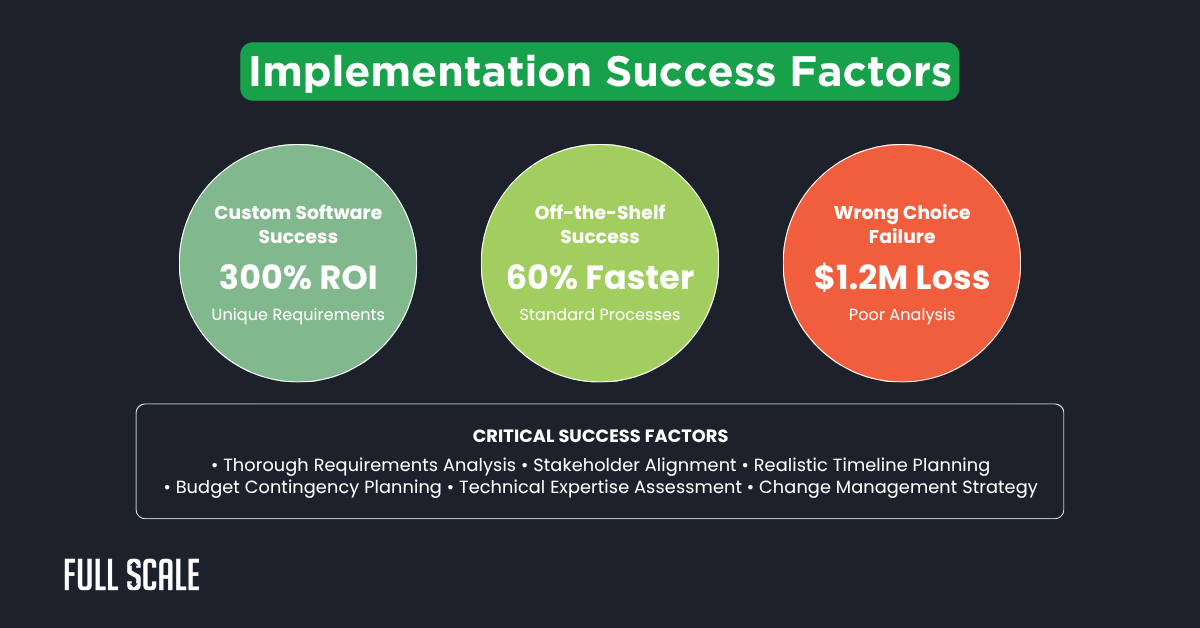
Implementation Best Practices
Successful software implementation requires systematic planning, stakeholder alignment, and comprehensive risk management. Implementation approaches differ significantly between custom software development and off-the-shelf deployment. Understanding best practices ensures optimal outcomes regardless of the chosen software approach.
For Custom Software Development
Successful custom software projects require systematic vendor selection and comprehensive project management. Choosing a custom software development company involves technical expertise and portfolio. Custom software development services selection determines project success probability and quality.
Vendor Selection Framework
| Evaluation Criteria | Weight | Assessment Method |
| Technical Expertise | 30% | Code reviews and architecture assessments |
| Industry Experience | 25% | Portfolio analysis and client references |
| Communication Skills | 20% | Project management and reporting processes |
| Development Process | 15% | Agile methodology and quality assurance |
| Cost Structure | 10% | Transparent pricing and payment terms |
Development Process Requirements: Agile methodology enables iterative development and continuous requirement refinement throughout the project lifecycle. Regular milestone reviews ensure project alignment with business objectives and quality standards. Quality assurance protocols include automated testing frameworks and comprehensive code processes.
Documentation standards facilitate knowledge transfer and long-term maintenance capability development. Version control systems track all changes and enable effective team collaboration. Continuous integration automates testing procedures and streamlines deployment processes significantly.
Custom software development company selection requires evaluation of technical capabilities and expertise. The custom software vs. off-the-shelf implementation complexity demands experienced teams.
For Off-the-Shelf Implementation
Off-the-shelf software success requires comprehensive vendor evaluation and strategic change management. Implementation planning addresses data migration complexity, user training requirements, and process alignment. Vendor stability assessment ensures long-term platform viability and support quality.
Vendor Evaluation Checklist
- Financial stability and market position analysis supporting long-term viability
- Product roadmap alignment with business requirements and growth projections
- Integration capabilities and comprehensive API documentation availability
- Support quality standards and response time commitment guarantees
- Security certifications and regulatory compliance standard adherence
Change Management Strategy: User adoption drives software implementation success across all organizational levels effectively. Training programs address feature utilization optimization and workflow integration requirements. Communication plans explain implementation benefits and address potential resistance concerns.
Performance monitoring tracks key metrics and identifies optimization opportunities throughout the phases. Regular user feedback sessions guide configuration improvements and additional needs.
Risk Mitigation Strategies
Software projects face significant technical, financial, and operational risks requiring management approaches. Contract negotiation addresses intellectual property rights, performance guarantees, and termination protections. Backup planning ensures business continuity during implementation challenges and potential setbacks.
Contract Protection Elements
- Source code escrow arrangements for custom development project protection
- Performance benchmarks with penalty clauses ensuring quality delivery standards
- Milestone-based payment structures reduce financial exposure and risk accumulation
- Termination rights with a comprehensive asset transfer provision guarantee
Regular progress monitoring identifies potential issues before critical project delays occur. Quality gates prevent substandard deliverable acceptance and ensure requirement compliance. Risk registers track potential problems and document a comprehensive mitigation strategy.
The custom software vs. off-the-shelf risk profile requires different mitigation approaches. Contingency planning strategies address vendor dependencies and technical implementation challenges.
ROI Calculation Framework
Return on investment analysis requires a comprehensive evaluation of development costs and benefits. The custom software ROI calculator methodology differs significantly from off-the-shelf investment approaches. Accurate ROI calculation guides strategic decision-making and budget allocation optimization.
Custom Software ROI Model
Custom software ROI calculation includes development cost amortization and ongoing value generation. Initial investment spreads across the project lifespan, typically spanning 5-7 years, depending on evolution. Productivity gains, operational cost savings, and revenue increases contribute to return calculations.
ROI Calculation Components
| Factor | Calculation Method | Typical Impact |
| Development Cost Amortization | Total Cost ÷ Project Lifespan | 15-20% annual expense |
| Maintenance Cost Projection | 15-20% of development cost annually | Ongoing operational cost |
| Productivity Gain Monetization | Time Savings × Employee Costs | 20-40% efficiency improvement |
| Competitive Advantage Value | Revenue Attribution | 10-30% market share impact |
Sample ROI Calculation: $500,000 custom software development investment with 5-year amortization equals $100,000 cost allocation. Productivity gains are worth $180,000 annually through automation and workflow efficiency improvements. Competitive advantages generate $220,000 additional revenue through market differentiation.
Net annual benefit calculation: $300,000 ($180,000 + $220,000 – $100,000). Five-year ROI projection: 200% return on initial investment through benefits. Custom software investment ROI typically exceeds off-the-shelf alternatives beyond timelines.
Off-the-Shelf ROI Model
Off-the-shelf software ROI focuses on subscription costs, implementation expenses, and benefit quantification. Predictable monthly fees enable accurate cost forecasting and budget planning processes. Vendor-provided updates and support reduce internal IT overhead and maintenance expenses.
Cost Structure Analysis: Annual subscription fees compound with user growth and feature addition requirements. Customization expenses often exceed initial budget projections, requiring additional investment allocation. Integration costs vary significantly based on existing system complexity and requirements.
Value Driver Assessment: Rapid deployment generates immediate productivity benefits and operational efficiency improvements. Vendor expertise reduces implementation risks and learning curve complexity significantly. Regular updates provide ongoing feature enhancements without additional development investment.
The custom software vs. off-the-shelf ROI comparison reveals different value patterns. Financial analysis demonstrates cost-benefit variations across deployment timeframes and organizational requirements.
Comparative Analysis Template
Side-by-side ROI comparison guides strategic software selection decisions across organizational groups. Break-even analysis identifies precise cost parity timeframes supporting investment decision-making. Sensitivity analysis tests the accuracy under different growth scenarios and conditions.
5-Year Comparative Projection
| Metric | Custom Software | Off-the-Shelf | Difference |
| Initial Investment | $500,000 | $150,000 | $350,000 |
| Annual Operating Cost | $75,000 | $180,000 | -$105,000 |
| 5-Year Total Cost | $875,000 | $1,050,000 | -$175,000 |
| Break-Even Point | Month 30 | N/A | 30 months |
Custom software achieves a lower total cost of ownership after 30 months. Annual savings of $105,000 justify the initial investment premium through operational efficiency. Sensitivity analysis tests different user growth rates and cost inflation impacts.
Software development cost comparison supports custom development for applications exceeding timelines. The custom software vs. off-the-shelf financial analysis enables data-driven decisions.
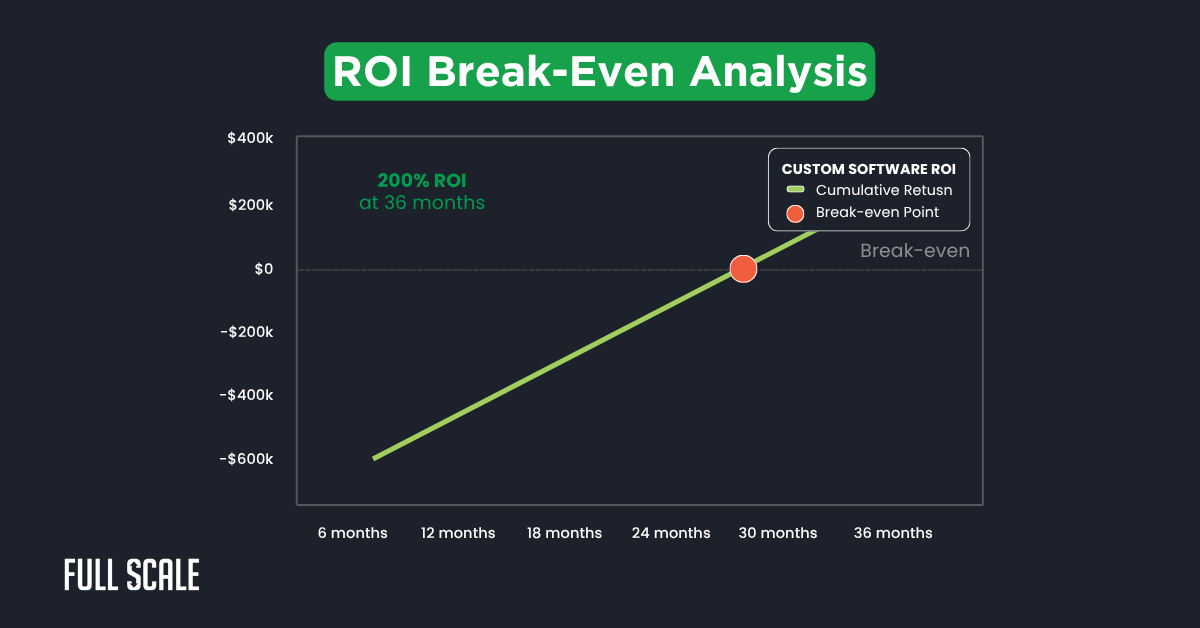
Strategic Decision Optimization for Long-Term Success
Future-proofing software decisions requires a comprehensive analysis of technology evolution trends and projections. Custom software enables direct control over updates, modernization timelines, and improvements. Off-the-shelf solutions depend entirely on vendor roadmaps and strategic priorities.
Vendor stability assessment evaluates long-term platform viability across multiple risk factors. Financial health analysis, market position evaluation, and acquisition risk assessment software. Vendor lock-in considerations include data portability capabilities and migration complexity analysis.
Future-Proofing Evaluation Framework
- Technology stack modernity and regular update frequency commitments
- API stability guarantees and backward compatibility maintenance policies
- Data export capabilities supporting standard format accessibility
- Integration flexibility supporting emerging technology adoption requirements
- Scalability planning accommodating a 10x growth scenario demands
Migration planning addresses potential platform changes and vendor transition requirements proactively. Documentation standards facilitate comprehensive knowledge transfer and system understanding development. Modular architecture design enables partial updates and component replacement strategies.
The custom software vs. off-the-shelf longevity comparison favors custom solutions. Technology evolution requires adaptive capabilities supporting continuous improvement and advantage.
Making Your Strategic Software Decision: Key Takeaways and Implementation Roadmap
Software procurement decisions significantly impact organizational efficiency, competitive market positioning, and performance. Custom software provides optimal solutions for unique business requirements and scalable potential. Off-the-shelf solutions offer rapid deployment capabilities and predictable cost structures.
Decision frameworks guide systematic evaluation of technical requirements, budget constraints, and opportunities. ROI analysis quantifies financial benefits and establishes realistic break-even timeline expectations. Risk mitigation strategies address common implementation challenges and vendor dependency effectively.
Strategic Action Framework by Organizational Role
- CTOs: Evaluate technical architecture requirements and comprehensive scalability projections supporting growth
- Product Directors: Assess competitive differentiation needs and time-to-market pressure impacts on strategy
- CFOs: Calculate detailed total cost of ownership and comprehensive ROI projection analysis
- HR Directors: Plan comprehensive change management and training requirement strategies
The custom software vs. off-the-shelf evaluation requires a thorough analysis of organizational requirements. Custom software development cost justification depends on competitive advantage requirements and potential. Growing businesses must balance immediate deployment needs with positioning.
Cost-benefit analysis software procurement supports data-driven decision-making processes and allocation strategies. Enterprise software build vs. buy analysis requires comprehensive stakeholder alignment and planning. The custom software vs. off-the-shelf comparison ultimately depends on specific requirements and strategies.
Explore Custom Software Development
FAQs: Custom Software vs. Off-the-Shelf Solutions
What is custom software with an example?
Custom software represents applications built specifically for one organization’s unique requirements and advantages. Examples include Spotify’s music recommendation algorithm, Netflix’s content delivery optimization system, and proprietary software.
What is considered custom software?
Custom software includes any application developed exclusively for specific business processes and workflows. This encompasses internal operational tools, customer-facing applications, and proprietary system integrations.
Can I create software on my own?
Individual software creation is possible for simple applications using low-code platforms or skills. Enterprise-grade custom software requires experienced development teams and comprehensive project expertise.
Where is custom software used?
Custom software serves unique business processes across diverse industries and organizational functions. FinTech companies deploy custom trading platforms, and healthcare organizations implement management systems.
How much does custom software development cost?
Custom software development cost ranges from $100,000 to $5 million depending on complexity. Simple business applications average $150,000-$300,000 while enterprise systems typically cost significantly more.
When should growing businesses choose custom software over off-the-shelf?
Growing businesses benefit from custom software when unique competitive advantages are required. Companies projecting significant growth typically need custom solutions supporting unlimited expansion.

Matt Watson is a serial tech entrepreneur who has started four companies and had a nine-figure exit. He was the founder and CTO of VinSolutions, the #1 CRM software used in today’s automotive industry. He has over twenty years of experience working as a tech CTO and building cutting-edge SaaS solutions.
As the CEO of Full Scale, he has helped over 100 tech companies build their software services and development teams. Full Scale specializes in helping tech companies grow by augmenting their in-house teams with software development talent from the Philippines.
Matt hosts Startup Hustle, a top podcast about entrepreneurship with over 6 million downloads. He has a wealth of knowledge about startups and business from his personal experience and from interviewing hundreds of other entrepreneurs.
